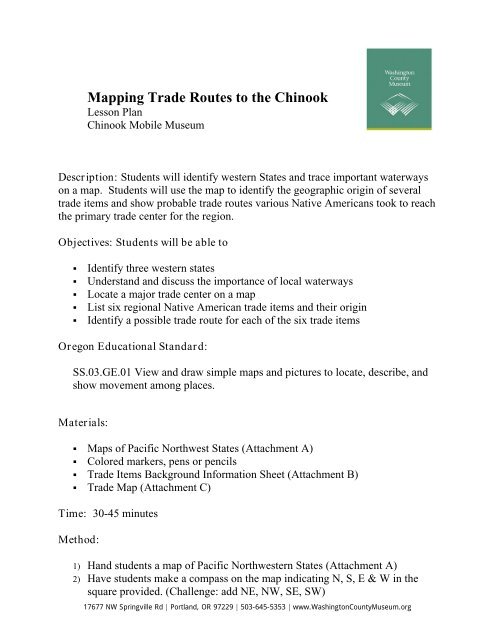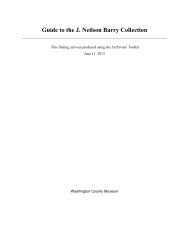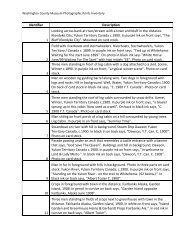Mapping Trade Routes to the Chinook - Washington County Museum
Mapping Trade Routes to the Chinook - Washington County Museum
Mapping Trade Routes to the Chinook - Washington County Museum
You also want an ePaper? Increase the reach of your titles
YUMPU automatically turns print PDFs into web optimized ePapers that Google loves.
<strong>Mapping</strong> <strong>Trade</strong> <strong>Routes</strong> <strong>to</strong> <strong>the</strong> <strong>Chinook</strong>Lesson Plan<strong>Chinook</strong> Mobile <strong>Museum</strong>Description: Students will identify western States and trace important waterwayson a map. Students will use <strong>the</strong> map <strong>to</strong> identify <strong>the</strong> geographic origin of severaltrade items and show probable trade routes various Native Americans <strong>to</strong>ok <strong>to</strong> reach<strong>the</strong> primary trade center for <strong>the</strong> region.Objectives: Students will be able <strong>to</strong>• Identify three western states• Understand and discuss <strong>the</strong> importance of local waterways• Locate a major trade center on a map• List six regional Native American trade items and <strong>the</strong>ir origin• Identify a possible trade route for each of <strong>the</strong> six trade itemsOregon Educational Standard:SS.03.GE.01 View and draw simple maps and pictures <strong>to</strong> locate, describe, andshow movement among places.Materials:• Maps of Pacific Northwest States (Attachment A)• Colored markers, pens or pencils• <strong>Trade</strong> Items Background Information Sheet (Attachment B)• <strong>Trade</strong> Map (Attachment C)Time: 30-45 minutesMethod:1) Hand students a map of Pacific Northwestern States (Attachment A)2) Have students make a compass on <strong>the</strong> map indicating N, S, E & W in <strong>the</strong>square provided. (Challenge: add NE, NW, SE, SW)17677 NW Springville Rd | Portland, OR 97229 | 503-645-5353 | www.Washing<strong>to</strong>n<strong>County</strong><strong>Museum</strong>.org
3) Ask students <strong>to</strong> locate Washing<strong>to</strong>n, Oregon and Idaho and label each state.(Challenge: identify and label <strong>the</strong> surrounding states and country). Outlineborders with colored pencil or marker <strong>to</strong> reinforce each state’s shape.4) Ask students what body of water lies <strong>to</strong> <strong>the</strong> west of Oregon.a. Label and color <strong>the</strong> Pacific Ocean.5) Ask students what river runs between Washing<strong>to</strong>n and Oregon.a. Label and color <strong>the</strong> Columbia River6) Ask students if <strong>the</strong>y know what a tributary is. Review vocabulary.a. A tributary is a river or stream that flows in<strong>to</strong> a larger stream or o<strong>the</strong>rbody of water.7) Ask students for <strong>the</strong> name of <strong>the</strong> tributary that flows north through Portland<strong>to</strong> <strong>the</strong> Columbia. Have students:a. Label and color <strong>the</strong> Willamette River.b. Use an arrow <strong>to</strong> illustrate that <strong>the</strong> water runs north in<strong>to</strong> <strong>the</strong> Columbia.8) Ask students <strong>to</strong> emphasize <strong>the</strong> o<strong>the</strong>r tributaries that flow in<strong>to</strong> <strong>the</strong> Columbia(dark lines on paper) by tracing <strong>the</strong>m in blue.9) Have students locate <strong>the</strong> dotted circle shown on <strong>the</strong> map. Explain that thiscircle identifies <strong>the</strong> center of trade for tribes throughout <strong>the</strong> Northwest,specifically <strong>the</strong> <strong>Chinook</strong>. Have <strong>the</strong>m discuss why this site may have become<strong>the</strong> major trading site for <strong>the</strong> region. (Remind <strong>the</strong>m that <strong>the</strong> site could drawtraders from a variety of physical environments with a variety of naturalresources <strong>to</strong> exchange or barter, and that <strong>the</strong> waterways made this siteaccessible <strong>to</strong> many.)10) Trace over <strong>the</strong> dotted circle in red and label as “major trade center” (locatedwhere <strong>the</strong> present city of <strong>the</strong> Dalles is found)11) Have students look at <strong>the</strong> six labeled dots and <strong>the</strong> list of trade items. Have<strong>the</strong>m work in groups, or as a class, <strong>to</strong> determine which trade items camefrom which locations. (Some trade items are more general than o<strong>the</strong>rs.Students can use process of elimination <strong>to</strong> fill in all <strong>the</strong> lines. Studentgroups may use <strong>the</strong> “<strong>Trade</strong> Items Background Information Sheet.”(Attachment B) Review as a class, or have groups make presentations about<strong>the</strong>ir trade item <strong>to</strong> <strong>the</strong> class.12) Use colored pencils <strong>to</strong> illustrate probable routes Native Americans <strong>to</strong>ok <strong>to</strong>get from <strong>the</strong>ir homes <strong>to</strong> <strong>the</strong> trade site.13) Discuss: Did all tribes depend upon waterways? Did all traders go <strong>the</strong>distance <strong>to</strong> <strong>the</strong> primary trade center, or might some have traded with o<strong>the</strong>rsalong <strong>the</strong> way?14) Show Attachment C <strong>to</strong> <strong>the</strong> class and discuss <strong>the</strong> various ways maps can help<strong>to</strong> illustrate movement across <strong>the</strong> area.17677 NW Springville Rd | Portland, OR 97229 | 503-645-5353 | www.Washing<strong>to</strong>n<strong>County</strong><strong>Museum</strong>.org







